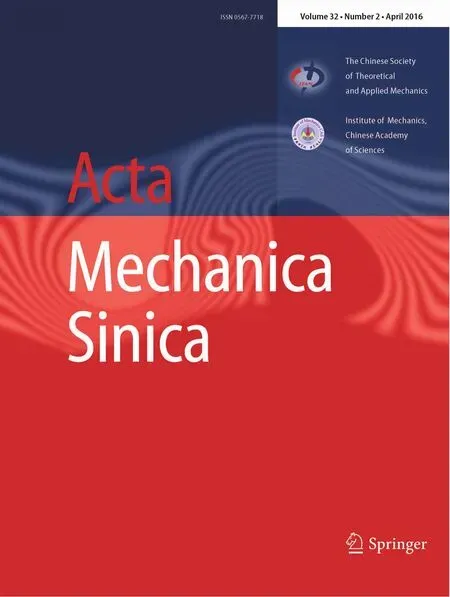Research on the mechanics of high speed rails
Yujie Wei
?
Research on the mechanics of high speed rails
Yujie Wei1
Published online:26 April 2016
?The Chinese Society of Theoretical and Applied Mechanics;Institute of Mechanics,Chinese Academy of Sciences and Springer-Verlag Berlin Heidelberg 2016
In the preceding theme issue on“Current research progress on mechanics of high speed rails”(Acta Mechanica Sinica, 30:846-909(2014)),we invited several authors in the fiel topresenttheirresearchonhighspeedrails(HSR),including work on dynamic derailment analysis(Ling et al.[1]),load spectra on bogie frame(Zhu et al.[2]),high-speed vehicle dynamics model(Ren et al.[3]),hunting stability analysis for the safety bound of speeds(Zeng et al.[4]),harvest kinetic energy of rail vibration by using piezoelectric circular diaphragm(Wang et al.[5]),and welding distortion for double floo structure of high speed train(Dong et al.[6]).
In order to develop a comprehensive understanding about thedynamicsandlong-termdurabilityofHSRsystems,there is a prevailing need for new research from multidisciplinary groups.The theme articles published in this issue are the result of our continual endeavors to introduce cutting-edge research on the mechanics of HSR,from researchers of different backgrounds and working on different aspects of the system.
One focus of the theme articles is on the aerodynamic design ofhigh speed trains.Inthe paper by Guo et al.[7],the effectsofaffiliate componentsandtrainlengthontrainwind areanalyzed.Astrainsrunontrack,moresevereaerodynamics may be encountered when two trains pass by;the work by Li et al.[8]captured the dynamic responses of a carriage under the combined excitation from the track spectrum and airpressurepulseinthat scenario.One ofthechiefengineers fromCSRQingdaoSifangLocomotive&RollingStockCo., Dr.Ding and coauthors[9]summarized the critical optimizing factors for better aerodynamic performance of high speedtrains(HSTs).Theyconstructedtheoptimizationstrategy among the aerodynamic design principle,aerodynamic performance indexes,and design variables.The method has been successfully employed to the design of various HSTs, includingCRH380A,CRH380AM,CRH6,CRH2G,andthe standard electric multiple unit(EMU).
The second focus of the theme articles is on the dynamics oftrain-wheel-trackinteraction.ThestudybyHanetal.[10]presented their model to understand the nonlinear water-soil interaction during HST-track coupling,in particular when theslabtrackisundertheinfluenc ofsubgradedeformation. The work of Xu et al.[11]analyzed the torque transmitting performance during regenerative braking and proposed a novel methodology to detect the wheel-rail adhesion stability.Their analysis for the wheel-rail adhesion control for regenerative braking systems of HSTs is crucial to maintaining stability,improving adhesion use,and achieving high efficien y energy recovery.The model by Zhong et al.[12]was developed to investigate how the fl xibility of a train’s wheelset may impact vehicle-track dynamics.Within the speed range of 200-400 km/h,their model can characterize theeffectsoffl xiblewheelsetdeformationonthewheel-rail rolling contact behaviour very well.We also have one piece of paper on fault diagnosis for bearings—a critical component of trains.A work by Wang et al.[13]showed a strategy to monitor potential bearing faults.Their experimental techniques,combined with numerical analysis,could be applied to differentiate relevant signals to operational conditions of bearings from noises emitted from the surrounding environment.
As discussed before,there is tremendous progress in the research of HSR systems within the past decade,boosted by the huge marketing growth in China and worldwide.Withincreasing population to use HSTs for long-distance travelling,weexpecttherecouldbegrowingresearchopportunities on the safety,durability,energy efficien y,and environmental friendliness for HSRs,and we look forward to seeing continual research progress on such directions.
References
1.Ling,L.,Xiao,X.-B.,Jin,X.-S.:Development of a simulation model for dynamic derailment analysis of high-speed trains.Acta Mech.Sin.30,860-875(2014)
2.Zhu,N.,Sun,S.-G.,Li,Q.,et al.:Theoretical research and experimental validation of quasi-static load spectra on bogie frame structuresofhigh-speedtrains.ActaMech.Sin.30,901-909(2014)
3.Ren,Z.-S.,Yang,G.,Wang,S.-S.,et al.:Analysis of vibration and frequency transmission of high speed EMU with fl xible model. Acta Mech.Sin.30,876-883(2014)
4.Zeng,X.-H.,Han,W.,Lai,J.,et al.:Influence of aerodynamic loads on hunting stability of high-speed railway vehicles and parameter studies.Acta Mech.Sin.30,889-900(2014)
5.Wang,W.,Huang,R.-J.,Huang,C.-J.,et al.:Energy harvester arrayusingpiezoelectriccirculardiaphragmforrailvibration.Acta Mech.Sin.30,884-888(2014)
6.Dong,W.-C.,Lu,S.-P.,Lu,H.,et al.:Numerical simulation and control of welding distortion for double floo structure of high speed train.Acta Mech.Sin.30,849-859(2014)
7.Guo,D.,Shang,K.,Zhang,Y.,et al.:Influence of affiliate componentsandtrainlengthonthetrainwind.ActaMech.Sin.(2015). doi:10.1007/s10409-015-0553-z
8.Li,S.,Zheng,Z.,Yu,J.,et al.:Dynamic simulation and safety evaluation of high-speed trains meeting in open air.Acta Mech. Sin.(2015).doi:10.1007/s10409-015-0471-0
9.Ding,S.-S.,Li,Q.,Tian,A.-Q.,et al.:Aerodynamic design on high-speed trains.Acta Mech.Sin.(2015).doi:10.1007/ s10409-015-0546-y
10.Han,J.,Zhao,G.-T.,Sheng,X.-Z.,et al.:Study on the subgrade deformation under high-speed train loading and water-soil interaction.Acta Mech.Sin.(2015).doi:10.1007/s10409-015-0522-6
11.Xu,K.,Xu,G.-Q.,Zheng,C.-H.:Analysis of torque transmitting behavior and wheel slip prevention control during regenerative brakingforhighspeedEMUtrains.ActaMech.Sin.(2015).doi:10. 1007/s10409-015-0544-0
12.Zhong,S.,Xiao,X.,Wen,Z.,etal.:Effectofwheelsetfl xibilityon wheel-rail contact behavior and a specifi coupling of wheel-rail contact to fl xible wheelset.Acta Mech.Sin.(2015).doi:10.1007/ s10409-015-0441-6
13.Wang,W.-J.,Cui,L.-L.,Chen,D.-Y.:Multi-scale morphology analysis of acoustic emission signal and quantitative diagnosis for bearing fault.Acta Mech.Sin.(2015).doi:10.1007/ s10409-015-0529-z
?Yujie Wei
yujie_wei@LNM.imech.ac.cn
1LNM,Institute of Mechanics,Chinese Academy of Sciences, Beijing 100190,China
- Acta Mechanica Sinica的其它文章
- Acoustic emission assessment of interface cracking in thermal barrier coatings
- Why a mosquito leg possesses superior load-bearing capacity on water:Experimentals
- An efficien formulation based on the Lagrangian method for contact–impact analysis of flexibl multi-body system
- Correcting the initialization of models with fractional derivatives via history-dependent conditions
- Impact toughness of a gradient hardened layer of Cr5Mo1V steel treated by laser shock peening
- The equilibrium stability for a smooth and discontinuous oscillator with dry friction

